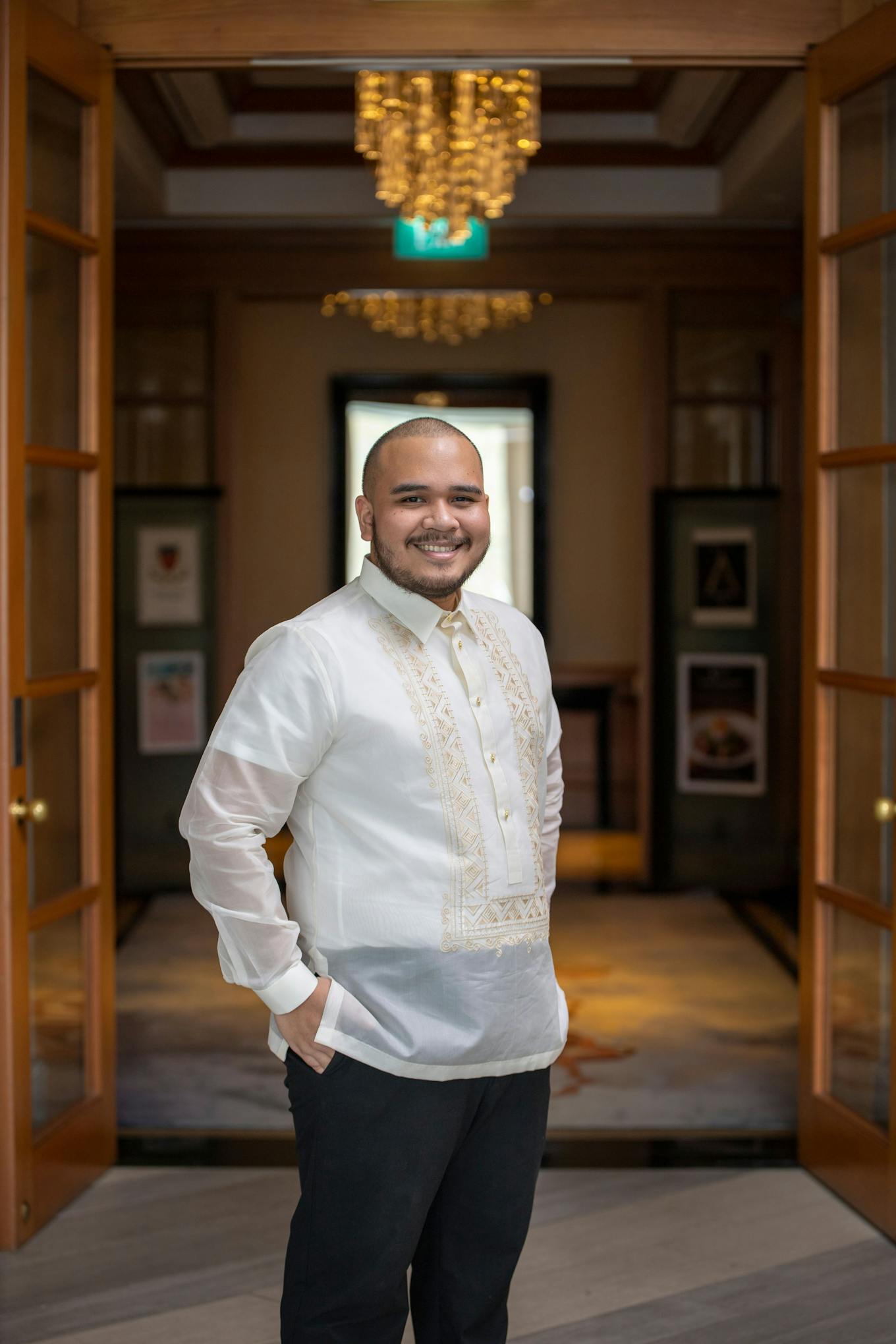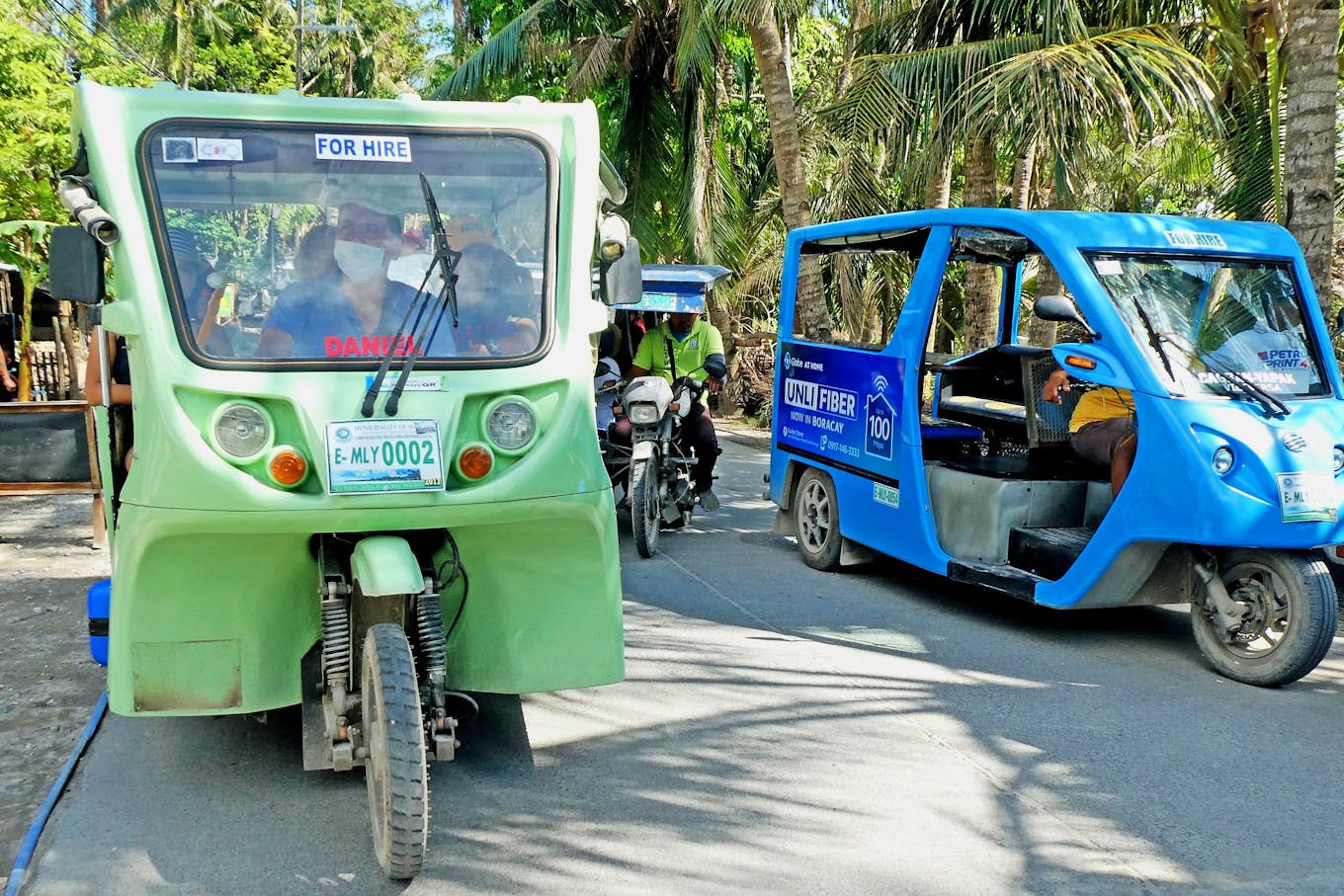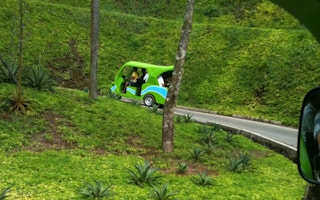Along with jeepneys, motorised tricycles are a quintessential part of Filipino life. They ply both rural and urban roads in the archipelago, and are reminiscent of the auto-rickshaws or tuk-tuks in other Southeast Asian countries.
To continue reading, subscribe to Eco‑Business.
There's something for everyone. We offer a range of subscription plans.
- Access our stories and receive our Insights Weekly newsletter with the free EB Member plan.
- Unlock unlimited access to our content and archive with EB Circle.
- Publish your content with EB Premium.
Hence, when chief executive of GerWeiss Motors Sean Gabriel Villoria wanted to champion electric tricycles – or e-trikes – in the island provinces of the Philippines, he knew he’d meet with some opposition.

Sean Gabriel Villoria took over GerWeiss Motors from his parents in 2018 at the age of 23, after serving as Chief Technology Officer of the company for some years. Image: Firdaus Firlany/Eco-Business
“When you are trying to change something that has been part of the Filipino experience for so long – even when you are trying to improve it – it’s never going to be a smooth transition,” Villoria told Eco-Business.
Both jeepneys and tricycles are the smoke-belching “kings” of Philippine roads. Removing some 100,000 gasoline-guzzling tricycles from Philippine public transport could help avoid some 260,000 tonnes of carbon dioxide emissions annually, according to statistics from the Department of Energy. Replacing them with energy-efficient e-trikes could lead to 561,000 barrels in fossil fuel consumption averted per year.
GerWeiss Motors, a manufacturing company founded by Villoria’s parents in 2008, first started an assembly and servicing facility for e-trikes on the small island destination Boracay in the central Philippines in 2013. Boracay is more commonly known for its idyllic seasides – it welcomes up to 150,000 foreign and domestic visitors every month – but the sustainability of its tourism industry has also been called into question in the past few years.
A main problem is pollution, caused partly by the lack of a proper sewage and waste management system on the island, as well as emissions from tricycles, which it is heavily reliant on, due to the islet’s slopey terrain and narrow roads.
Villoria, taking over the company in 2018 at the age of 23, after serving as its chief technology officer for some years, is behind GerWeiss Motors’ push in multiplying its e-trike fleet to some 30 per cent of the total tricycle population on Boracay, which are now already fully electric. Villoria said Boracay’s local motorists and drivers initially expressed reluctance to adopt the e-trikes, worried for the loss of their livelihoods and whether it will be costly to adopt the technology, so the firm’s first priority was to assuage these concerns, by ensuring an efficient and effective access model.
The push for EVs has to be a conscious effort. We can’t just dictate drivers to go electric. We don’t want this transition to become their burden.
Sean Gabriel Villoria, CEO, GerWeiss Motors
Boracay now has in place an e-trike ecosystem that includes facilities for fast charging, battery hot swapping and solar charging, as well as local maintenance and service systems. Users are able to make payments via e-wallets, and Villoria says the locally-designed e-trikes are able to travel at least 70 kilometres on a single charge. GerWeiss Motors also adopts a pay-per-use system so that drivers can gain access to the e-trikes without having to shell out the entire cost of the electric vehicles. The firm now partners with some 150 drivers on Boracay.
Villoria, who’s been recognised by the Eco-Business A-List 2022 for his advocacy for Boracay’s decarbonisation efforts, shares more about what electrification can do for sustainable tourism, and his plans for GerWeiss Motors to expand to other island destinations in the Philipppines.
What is one milestone that GerWeiss Motors has achieved in the past year?
I think the most important thing that we’ve accomplished with GerWeiss Motors in the past year, especially right after the pandemic, was helping to reestablish the livelihoods of Boracay’s drivers. In 2020, the local government of Malay, Aklan, whose jurisdiction Boracay is a part of, implemented a complete phaseout of all gasoline-fuelled tricycles on the island. A lot of drivers lost their livelihoods not only because of the lockdowns, but also because they were unable to purchase their own electric tricycles.
With our equitable pay-per-use model, we bridged this gap in electric vehicle access. Right now, the lease we charge drivers is less than what they would spend on gas daily. Our main focus is making sure the drivers, who are our partners, increase their income. They have told us that in making this switch to electric, at the very least, they have been able to double, or even triple their daily income. That’s part of why once they go electric, they never want to go back.
The pay-per-use model was borne out of our realisation that drivers often have a hard time maintaining these electric vehicles. This is how we assist them. Currently, we operate most of the vehicles, maintain them for our partner drivers and only charge them for their daily use.
What are your views on making sure that the EV transition is just?
The push for EVs has to be a conscious effort. We can’t just dictate that drivers go electric. We have to make sure that these drivers and their families can still make ends meet, and that we’re not putting them into situations where they will have a hard time. We don’t want this transition to become their burden.
The majority of the transportation on the island is now electrical. Our contribution to that is that we’re supporting almost 30 per cent of the total tricycles on the island. This 30 per cent represents about 150 drivers and their families, who previously struggled during the pandemic due to the lack of tourists and the social distancing protocols implemented for public transport.
We are most proud that we are not only eliminating lots of emissions and air pollution from the island, but also empowering these drivers and uplifting them from poverty.

Replacing some 100,000 gasoline-guzzling tricycles with energy-efficient e-trikes could lead to 561,000 barrels in fossil fuel consumption averted per year, according to statistics from the Department of Energy. Image: Harry and Rowena Kennedy, CC BY-SA 3.0, via Flickr.
Tell us about the origins of GerWeiss Motors and how the manufacturing company came to be.
When my parents started this company in 2008, I was just 13 years old and I joined them at work almost every day. I think I can claim that I’ve been designing these vehicles since I was a teen.
They saw this huge potential in electric vehicles nearly two decades ago. My father recalls that at the time Tesla had just launched their first Roadster. That’s how long we’ve been in this business. We saw very early how much we could impact Filipino drivers’ lives by making our homegrown vehicles better and more innovative, as well as impacting passengers by making the EVs safer and friendlier to the environment.
How long has GerWeiss Motors been in Boracay and what made the company want to establish operations on the island?
Our family actually moved to Boracay in 2013. It was the best place we could start because it was a small island that really wanted to go electric.
Other than its natural charms, we feel that it was really just the best place for us to start because it was also the toughest. The conditions in Boracay, with all the salt in the air and its landscape as well, it’s a good test for our vehicles, it forces us to adapt and innovate. We are completely Filipino-designed in our manufacturing.
We have been here for almost ten years. We have worked with three different local government administrations in Boracay now, all of them with a strong unified push to make Boracay a sustainable tourist destination. It is our operations base. We’re driven to make this succeed.
We are also working on launching other small pilot projects in other cities, including Coron in Palawan, as well as Mandaluyong and Quezon City in Metro Manila.

Boracay is more commonly known for its idyllic seasides - it welcomes up to 150,000 foreign and domestic visitors every month - but the sustainability of its tourism industry has also been called into question in the past few years. Image: Rhick Lars Vladimer Albay/Eco-Business
What’s in the near future for GerWeiss Motors?
We are focusing primarily on tricycles now because that’s really been our bread and butter for the past 10 years. The vast majority of electric vehicles in the country will not be four-wheeler cars, it’s gonna be smaller light vehicles like e-trikes.
But as, you know, there is now also a modernisation programme for jeepneys and with the strong push from the Electric Vehicle Industry Development Act just passed this year, we’re also developing our own electric jeepney. So that should be coming sometime this year.
We’ve seen how desperately the tricycles, jeepneys and public transportation in general in the Philippines can be improved. With how things are going now, we believe that we’re in a position to grow.
The interview has been edited for brevity and clarity.
Sean Gabriel Villoria was one of 10 sustainability leaders selected for the Eco-Business A-List 2022.












